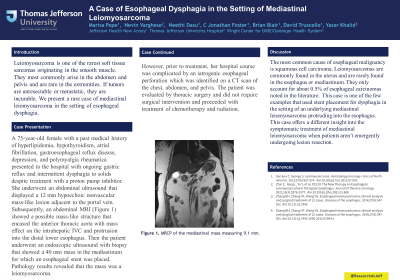Tuesday Poster Session
Category: Esophagus
P3313 - A Case of Esophageal Dysphagia in the Setting of Mediastinal Leiomyosarcoma
Tuesday, October 24, 2023
10:30 AM - 4:00 PM PT
Location: Exhibit Hall

Has Audio

Marisa Pope, DO
Jefferson Health
Stratford, NJ
Presenting Author(s)
Marisa Pope, DO1, Nevin Varghese, MD2, Neethi Dasu, DO3, C Jonathan Foster, DO4, Brian Blair, DO4, David Truscello, DO5, Yaser Khalid, DO6
1Jefferson Health, Stratford, NJ; 2Thomas Jefferson University Hospital, Philadelphia, PA; 3Jefferson Health, New Jersey, NJ; 4Jefferson Health, Cherry Hill, NJ; 5Jefferson Health, Sicklerville, NJ; 6Wright Center for GME/Geisinger Health System, Scranton, PA
Introduction: Leiomyosarcoma is one of the rarest soft tissue sarcomas originating in the smooth muscle. They most commonly arise in the abdomen and pelvis and are less common in the extremities. If tumors are unresectable or metastatic, they are incurable. We present a rare case of leiomyosarcoma in the mediastinum with esophageal protrusion causing dysphagia.
Case Description/Methods: A 75-year-old female with a past medical history of hyperlipidemia, hypothyroidism, atrial fibrillation, gastroesophageal reflux disease, depression, and polymyalgia rheumatica presented to the hospital with ongoing gastric reflux and intermittent dysphagia to solids despite treatment with proton pump inhibitor. She underwent an abdominal ultrasound that displayed a 12 mm hypoechoic nonvascular mass-like lesion adjacent to the portal vein. Subsequently, an abdominal MRI showed a possible mass-like structure that encased the anterior thoracic aorta with mass effect on the intrahepatic IVC and protrusion into the distal lower esophagus. Then the patient underwent an endoscopic ultrasound with biopsy that showed a 40 mm mass in the mediastinum for which an esophageal stent was placed. Pathology results revealed that the mass was a leiomyosarcoma. However, prior to treatment, her hospital course was complicated by an iatrogenic esophageal perforation which was identified on a CT scan of the chest, abdomen, and pelvis. The patient was evaluated by thoracic surgery and did not require surgical intervention and proceeded to treatment with chemotherapy and radiation which continues today.
Discussion: Primary Leiomyosarcomas arise from smooth muscle and are very rare. In the anterior mediastinum, they commonly arise from the esophagus or the great vessels. Based on the patient’s location of leiomyosarcoma within the anterior mediastinum, it is likely the tumor arose from the great vessels. Typically, treatment consists of surgical resection in the early stages of disease. This case shows an example of a unique treatment and diagnosis of leiomyosarcoma in a patient that did not require emergent surgical resection. In our case, endoscopic ultrasound was used to diagnose an extraesophageal mass and perform a fine needle ultrasound. Furthermore, esophageal stenting was utilized to help symptomatically relieve our patient’s dysphagia.
Disclosures:
Marisa Pope, DO1, Nevin Varghese, MD2, Neethi Dasu, DO3, C Jonathan Foster, DO4, Brian Blair, DO4, David Truscello, DO5, Yaser Khalid, DO6. P3313 - A Case of Esophageal Dysphagia in the Setting of Mediastinal Leiomyosarcoma, ACG 2023 Annual Scientific Meeting Abstracts. Vancouver, BC, Canada: American College of Gastroenterology.
1Jefferson Health, Stratford, NJ; 2Thomas Jefferson University Hospital, Philadelphia, PA; 3Jefferson Health, New Jersey, NJ; 4Jefferson Health, Cherry Hill, NJ; 5Jefferson Health, Sicklerville, NJ; 6Wright Center for GME/Geisinger Health System, Scranton, PA
Introduction: Leiomyosarcoma is one of the rarest soft tissue sarcomas originating in the smooth muscle. They most commonly arise in the abdomen and pelvis and are less common in the extremities. If tumors are unresectable or metastatic, they are incurable. We present a rare case of leiomyosarcoma in the mediastinum with esophageal protrusion causing dysphagia.
Case Description/Methods: A 75-year-old female with a past medical history of hyperlipidemia, hypothyroidism, atrial fibrillation, gastroesophageal reflux disease, depression, and polymyalgia rheumatica presented to the hospital with ongoing gastric reflux and intermittent dysphagia to solids despite treatment with proton pump inhibitor. She underwent an abdominal ultrasound that displayed a 12 mm hypoechoic nonvascular mass-like lesion adjacent to the portal vein. Subsequently, an abdominal MRI showed a possible mass-like structure that encased the anterior thoracic aorta with mass effect on the intrahepatic IVC and protrusion into the distal lower esophagus. Then the patient underwent an endoscopic ultrasound with biopsy that showed a 40 mm mass in the mediastinum for which an esophageal stent was placed. Pathology results revealed that the mass was a leiomyosarcoma. However, prior to treatment, her hospital course was complicated by an iatrogenic esophageal perforation which was identified on a CT scan of the chest, abdomen, and pelvis. The patient was evaluated by thoracic surgery and did not require surgical intervention and proceeded to treatment with chemotherapy and radiation which continues today.
Discussion: Primary Leiomyosarcomas arise from smooth muscle and are very rare. In the anterior mediastinum, they commonly arise from the esophagus or the great vessels. Based on the patient’s location of leiomyosarcoma within the anterior mediastinum, it is likely the tumor arose from the great vessels. Typically, treatment consists of surgical resection in the early stages of disease. This case shows an example of a unique treatment and diagnosis of leiomyosarcoma in a patient that did not require emergent surgical resection. In our case, endoscopic ultrasound was used to diagnose an extraesophageal mass and perform a fine needle ultrasound. Furthermore, esophageal stenting was utilized to help symptomatically relieve our patient’s dysphagia.
Disclosures:
Marisa Pope indicated no relevant financial relationships.
Nevin Varghese indicated no relevant financial relationships.
Neethi Dasu indicated no relevant financial relationships.
C Jonathan Foster indicated no relevant financial relationships.
Brian Blair indicated no relevant financial relationships.
David Truscello indicated no relevant financial relationships.
Yaser Khalid indicated no relevant financial relationships.
Marisa Pope, DO1, Nevin Varghese, MD2, Neethi Dasu, DO3, C Jonathan Foster, DO4, Brian Blair, DO4, David Truscello, DO5, Yaser Khalid, DO6. P3313 - A Case of Esophageal Dysphagia in the Setting of Mediastinal Leiomyosarcoma, ACG 2023 Annual Scientific Meeting Abstracts. Vancouver, BC, Canada: American College of Gastroenterology.
